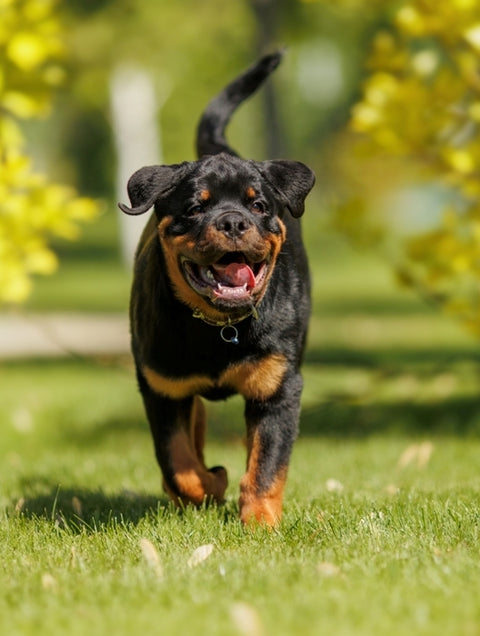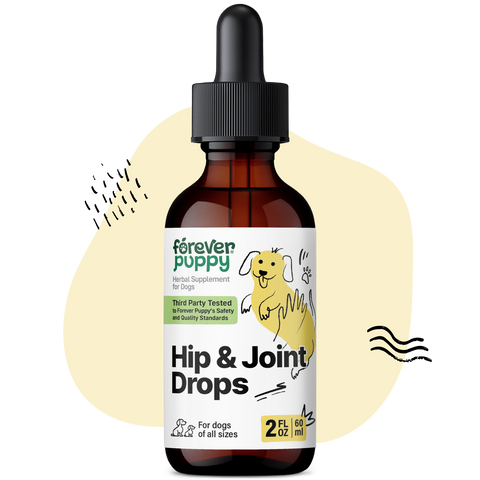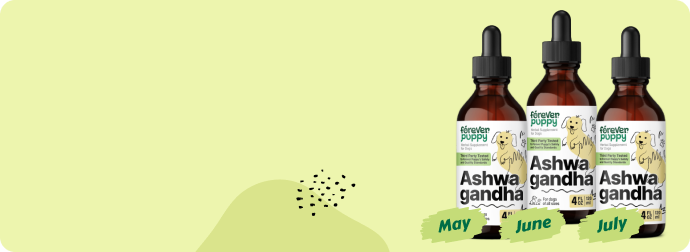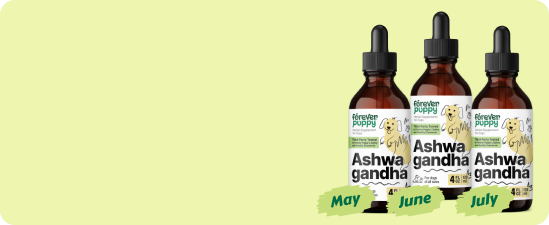
Rottweilers are big, strong and actually full of love. They’ll guard your house, cuddle on the couch and follow you from room to room like a fluffy little tank. But all that muscle and weight? It can be a lot for their joints to handle – especially as they get older.
Have you ever noticed your Rottie moving a little slower, struggling with stairs or giving you that “I’d rather not jump into the car” look? Joint care is a big deal for this breed, and the good news is, there’s a lot you can do to help.
This guide is all about giving those hard-working joints the support they deserve. We’ll walk you through what to look out for, how to keep your pup comfy and which supplements may help keep those hips and elbows feeling smooth.
Ready to help your big softie stay active and happy? Let’s get into it.
Why Rottweilers Need Joint Support?
Rottweilers are built like linebackers – strong, powerful and always ready to go. But underneath all that muscle, their joints are doing some serious heavy lifting. And over time, that can lead to trouble.
One study looked at 60 different dog breeds and found that Rottweilers had some of the highest rates of hip dysplasia – and not just that – they ranked second highest for elbow dysplasia too. These are real conditions that can lead to long-term joint damage, pain and eventually arthritis.
And as you’re probably aware, arthritis doesn’t just slow your dog down – it can make everyday things like getting up, climbing stairs or going for walks uncomfortable. That’s why giving your Rottie the right kind of joint support early on can make a big difference.
Whether your pup is still young and zooming or starting to take things a bit slower, caring for those joints now helps protect their happy, active future.
Rottweilers need extra attention to their joints, especially as they grow, age or carry a few extra pounds:
Let’s break it down by life stage:
- As puppies, Rotties grow fast. Like, really fast. Their bodies get big before their joints are fully ready for all that size. That’s why it’s important to avoid over-exercising a young Rottweiler and to give them the right nutrition early on. Extra stress during growth can raise their risk for joint problems later.
- In adulthood, they’re usually at their strongest – and heaviest. This is when joint issues like hip or elbow dysplasia might start to show up.
- As seniors, wear and tear naturally add up. Your Rottie might slow down a bit, take longer to get up in the morning or avoid stairs and jumping. That’s often a sign of stiff or sore joints. At this stage, it’s all about comfort, mobility and keeping them happy in their golden years.
Signs of Joint Discomfort in Rottweilers
Rottweilers are tough cookies. They don’t always show pain the way we expect. Sometimes it’s subtle – like your dog not wanting to go upstairs – or skipping the usual zoomies in the backyard. That’s why it’s important to know the early signs of joint discomfort, especially in a breed like this that’s already prone to hip and elbow issues.
Catching these signs early can help you take steps to support your pup and keep things from getting worse.
Here’s what to watch for:
-
Limping or favoring one leg
If your Rottie starts walking funny, limps after a nap or avoids putting weight on one leg, that’s a red flag. It could mean pain in the hip, knee or elbow – and it’s often more noticeable after play or long walks. -
Stiffness, especially after rest
Is your dog slow to get up in the morning? Or do they move like a robot for the first few steps after lying down? Stiffness is a classic sign of joint trouble and is often more obvious after periods of rest or cold weather. -
Decreased activity or “slowing down”
Some dogs get less active with age, but if your Rottie starts skipping walks, losing interest in playtime or tires out more easily than usual, it could be because moving just doesn’t feel good anymore. -
Licking or chewing at joints
Dogs usually try to “fix” what hurts by licking or chewing at sore spots. If your dog keeps focusing on a certain leg or joint, it might be their way of dealing with discomfort. -
Mood or behavior changes
Pain can make even the sweetest dog a little cranky. If your Rottweiler seems less patient, more withdrawn or snappy when touched, especially around their legs or back, they may be trying to tell you something’s not right.
Knowing these signs can help you stay ahead of joint issues and keep your big softie moving with comfort and confidence.
When in doubt, always check in with your vet – they can help pinpoint the cause and guide you on next steps.
How Weight Affects Joint Health
Rottweilers are solid, muscular dogs – but when they carry extra weight, it’s not just about looks. It directly affects their joints, and not in a good way.
Extra pounds = extra pressure
Every extra pound on your dog adds more stress to their joints – especially the hips, knees and elbows. In large breeds like Rottweilers, this pressure adds up quickly. It’s like carrying around a backpack all day, every day.
According to vets, even 5 extra pounds can make a big difference in how your dog moves and feels. The joints wear down faster, and there’s more strain on cartilage – the cushiony stuff that helps joints move smoothly.
The weight-pain cycle:
Weight gain doesn’t just happen on its own – it often leads to a cycle:
- Extra weight makes moving painful.
- Pain causes less movement.
- Less movement leads to more weight gain.
- More weight causes even more joint stress.
Breaking that cycle early is key. Helping your dog stay at a healthy weight is one of the best things you can do for long-term joint comfort.
Fat isn’t just “storage”!
Dog fat doesn’t just sit there. It actually releases inflammatory chemicals that can worsen joint inflammation and pain – especially in dogs with arthritis or dysplasia. So, managing your dog’s weight isn’t just about pressure – it also reduces the chemicals that fuel joint problems.
What you can do to help your Rottie stay lean and joint-happy:
- Watch portion sizes – even healthy food can add up fast.
- Use healthy treats – carrots, green beans or commercial low-calorie dog treats are great.
- Stick to regular walks – low-impact movement like walking or swimming keeps joints active and helps burn calories without stressing the body.
- Work with your vet – they can help you figure out your dog’s ideal weight and build a safe plan to get there.
Keeping your Rottweiler at a healthy weight means less pain, more play, and a longer, happier life.
Importance of Regular Exercise and Activity
Rottweilers are working dogs at heart. They were bred to move – herding cattle, running beside carts and staying alert all day. So it’s no surprise their bodies feel best when they stay active. But here’s the key: it’s not just about “burning energy.” Regular movement actually supports joint health.
1. Motion Is Joint Lotion
When your Rottie moves, it helps circulate synovial fluid – a slippery substance inside the joints that reduces friction and keeps everything gliding smoothly. No movement? That fluid thickens, joints get stiff and cartilage doesn’t get the nutrients it needs. Think of gentle movement as a daily oil change for your dog’s joints.
2. Maintains Muscle to Support Joints
Strong muscles do a big job: they support and stabilize joints, reducing the strain on the bones and cartilage. Regular activity keeps your dog’s muscle tone up, which in turn helps protect their joints from injury and long-term damage.
No exercise = weaker muscles = more joint load = more discomfort.
3. Low-Impact Activities Are Best
For dogs prone to joint issues (like Rottweilers), low-impact is the way to go. Skip the high jumps and marathon fetch games on hard pavement. Instead, aim for:
- Daily walks on grass or soft trails
- Swimming, if your dog enjoys water (it’s zero-impact and great for the whole body)
- Gentle play like tug-of-war, scent games or controlled fetch in short bursts
- Stretching and balance exercises (ask your vet about canine physical therapy moves)
4. Consistency Beats Intensity
Weekend warrior workouts don’t help much – and might even hurt. Instead, go for short, regular sessions every day. Even 20-30 minutes of movement spread across the day is enough to keep the joints lubricated, the muscles active and your dog’s weight in check.
5. Signs You’re Overdoing It
Watch for these signs that your Rottie may need a break:
- Limping after activity
- Hesitating to go for walks
- Sleeping more than usual after exercise
- Stiffness the next morning
When in doubt, rest. Gentle consistency is always better than one big push.
Bottom line: Movement matters. Regular, low-impact activity can help your Rottweiler stay limber, strong and comfortable at every age. It’s one of the simplest, most powerful things you can do for their joint health – and it makes their tail wag too.
Best Joint Supplements for Rottweilers
Supplements can be powerful tools when used the right way. If your Rottweiler’s joints need some extra care (and they probably do), the right blend of herbs can support joint comfort, mobility and long-term wellness.
Supplements are not quick fixes or overnight solutions, but with consistent use, they can help your dog stay active and comfy as they age. And remember, the best results happen when you combine supplements with a healthy weight, regular movement and vet check-ins.
if you're looking for a natural way to support your Rottie's joints, the following herbs are a great place to start:
Devil’s Claw
This herb comes from southern Africa and is often used to support normal joint function and mobility. It’s been used traditionally for generations to promote physical comfort, especially in large, active breeds.
Irish Sea Moss
Packed with natural minerals like iodine, magnesium and potassium, Irish sea moss supports overall vitality and connective tissue health. It also contains antioxidants, which help protect cells from everyday wear and tear – important for long-term joint care.
Sarsaparilla
Traditionally used to support skin and joint health, sarsaparilla is rich in plant compounds that help maintain a balanced immune response. It’s especially valuable in blends that aim to support the overall dog’s vitality.
Skullcap
Skullcap is an herb that supports nervous system health, but it also plays a role in physical relaxation and comfort. It’s often included in joint formulas to help calm overworked muscles and maintain normal mobility, especially in active or older dogs.
Turmeric
This golden root is a well-known supporter of joint and muscle comfort. It contains a natural compound called curcumin, which is often used to support joint flexibility and may help keep your dog feeling spry – even on those chilly mornings.
Ginger
Gentle on the tummy and helpful for joints, ginger has been traditionally used to support circulation and joint health. It’s a warming herb that works great alongside turmeric to keep your dog’s joints feeling balanced and supported during activity.
Willow
Willow bark has been used for centuries to support natural physical comfort. It contains salicin, a plant compound that’s often used to maintain comfort after activity. When used in the right amounts, it can be a safe and effective way to support a dog’s ease of movement.
All these herbs – and their joint-supporting goodness – are available in one ready-to-use herbal tincture from Forever Puppy. Our Hip & Joint Drops are designed for everyday use, with a thoughtful blend of natural ingredients that help support your Rottweiler’s joints from every angle. Just a few drops a day, and you’re giving your pup a plant-powered touch to stay comfortable, mobile and happy for years to come.
Forever Puppy Hip & Joint Drops - 4 fl.oz. Bottle
Why Choose Forever Puppy Joint Supplements for Rottweilers?
Our herbal drops are a simple, natural way to support your Rottweiler’s joints at any age. Just add a few drops to their food or water – no fuss, no weird flavors. Made with a gentle blend of herbs, this formula helps keep your dog moving comfortably and feeling their best. There’s no sugar, no alcohol and zero artificial stuff – just clean, plant-based support. It’s crafted for everyday use and designed to fit easily into your routine. Because taking care of your dog’s joints shouldn’t be complicated – it should just work!









